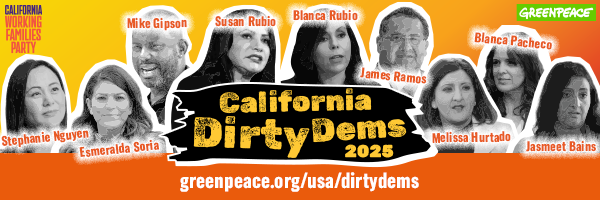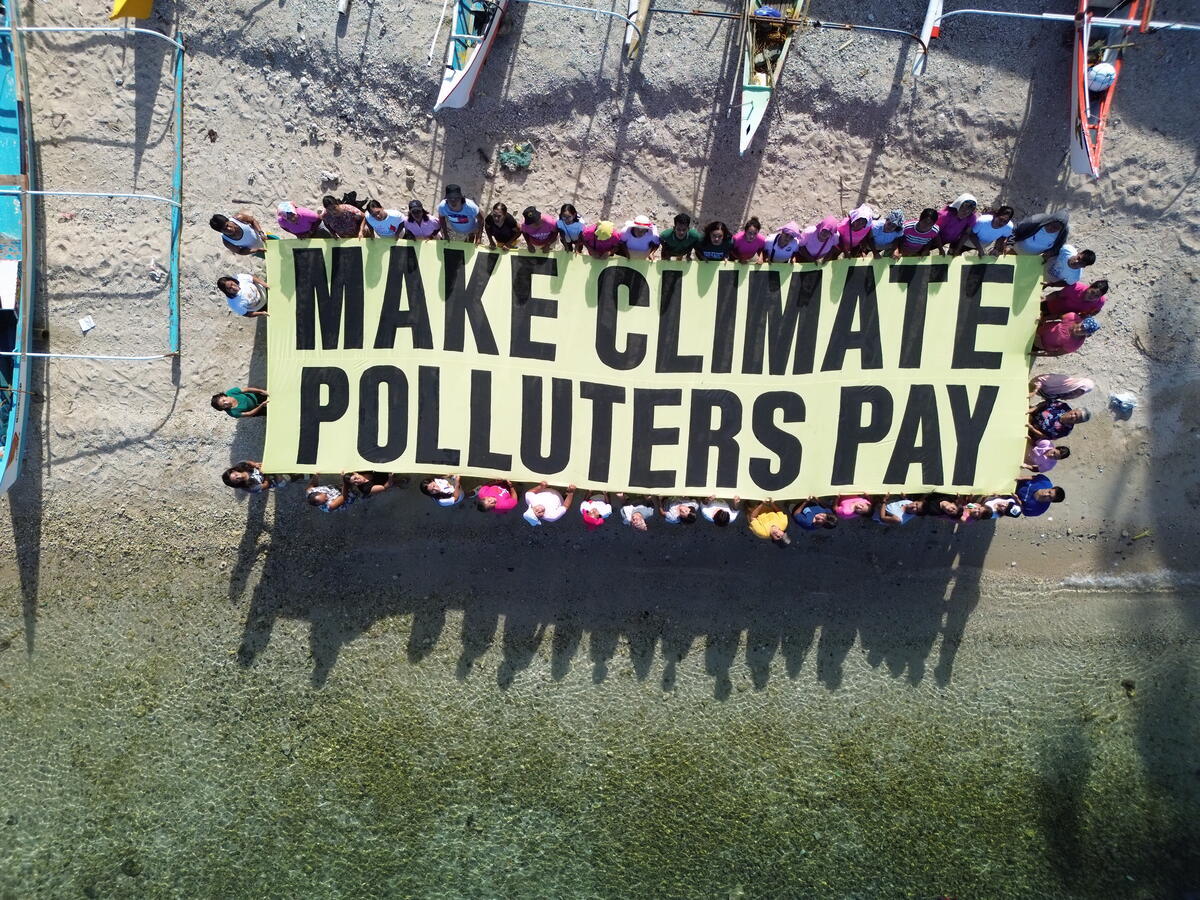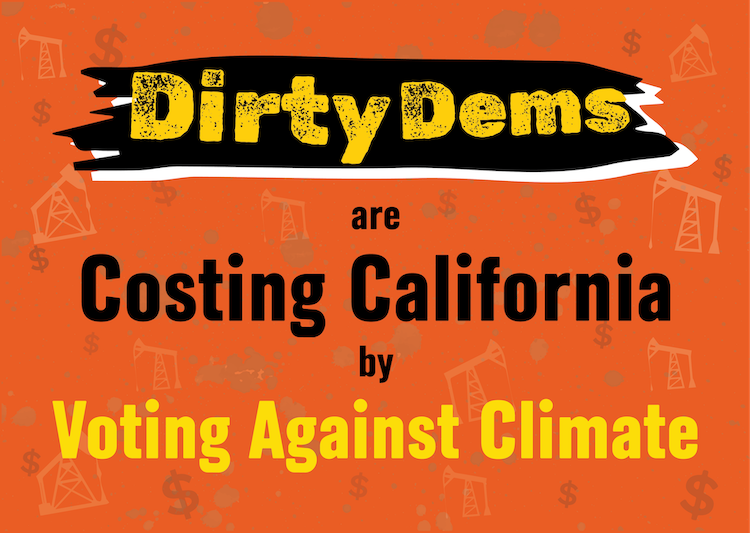Newsom climate report card, January 2021 update
2020 was a record-breaking year for the climate crisis in California. Ongoing drought and elevated temperatures fed an especially long and destructive wildfire season. Californians once again endured dangerous levels of smoke for weeks on end,[1] only this time they did so in the middle of a dangerous pandemic that attacks the respiratory system. The Covid-19 pandemic worsened the ongoing climate, public health, air pollution, housing, economic, and systemic racism crises, and highlighted the way those crises overlap and bring harm to vulnerable communities across the state.
Governor Gavin Newsom took advantage of the moment to connect the wildfires to the climate crisis and our reliance on fossil fuels. In September 2020, he issued an Executive Order requiring 100% of new passenger cars and trucks to be zero-emission vehicles by 2035.[2] Despite these steps, Newsom failed to make meaningful progress on a plan to phase out California’s oil and gas production, protect frontline communities from the health impacts of oil drilling, and ensure a just transition for workers and communities.
Based on his actions (and inaction) in 2020, Greenpeace is updating Newsom’s Climate Report Card to mark his performance on three core demands. While Newsom has taken small steps toward addressing the harmful impacts of fossil fuel extraction, his second year in office was largely marked by backward progress.
2020 report card
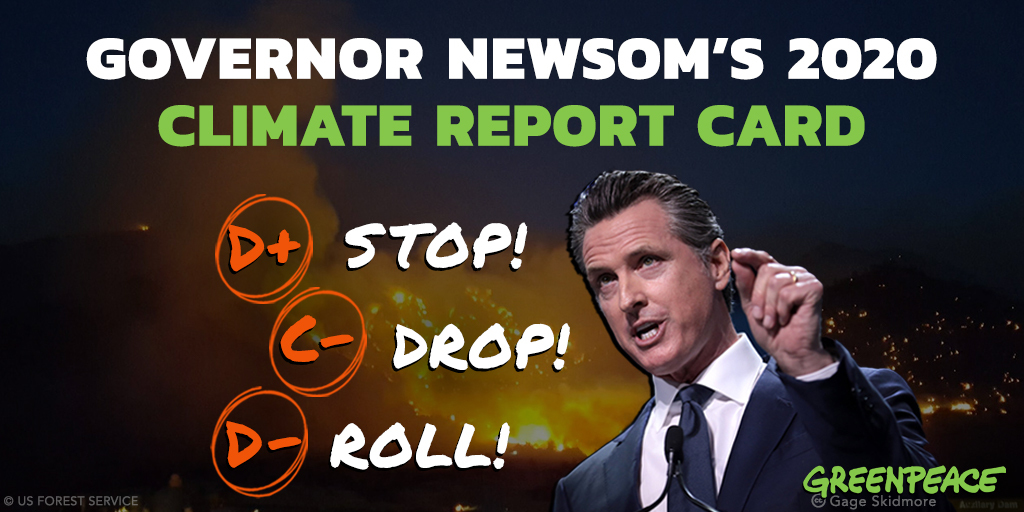
Permits for new oil and gas wells declined by 15.8% in 2020 compared to 2019, while permits for new oil and gas production wells more than doubled.[3] The overall decline in permits is due in part to an 82% decrease in well stimulation permits, driven by Newsom’s ongoing moratorium on cyclic steaming techniques.[4] Amid the downturn in global oil markets and a wave of bankruptcies in the industry, the actual number of new wells drilled has decreased since 2019, although this surge in new production well permits risks locking in future production.
However, Newsom has backtracked on the issue of fracking in California. After initiating a moratorium on new permits for fracking or acidizing in 2019, and despite earlier campaign statements opposing fracking,[5] Newsom handed out 128 new fracking permits in 2020 under a new scientific review process. These permits went to the state’s largest drillers, Aera Energy and Chevron.[6] The Governor also claimed not to have the legal authority to fully ban fracking himself, and called on the legislature to do so by 2024.
All told, Newsom has made supportive public statements about transitioning away from oil and gas, but fracking and new drilling permits continue to be approved at high rates. Newsom has not made sufficient regulatory changes to meaningfully halt or phase out oil and gas permitting in California.
2020 grade: D+
2019 grade: C-
Newsom’s Executive Order on the climate crisis called for the creation of a “Just Transition Roadmap” by July 2021. The EO called for a plan to expedite the remediation of inactive or orphaned wells which has the potential to create thousands of good paying jobs.[7] Newsom signed a budget that included funding for job training and income support for workers, and also signed AB 841, which would create jobs by upgrading HVAC systems in California’s schools and investing in EV charging infrastructure.[8]
Overall, Newsom has taken some actions to support workers and communities, but the transition off of fossil fuels will require bold commitments and significant investments to make sure no one is left behind. The scale, ambition and effectiveness of his actions remains to be seen.
2020 grade: C-
2019 grade: C-
During 2020, CalGEM began a public consultation process to draft regulations to protect the public health and safety of those who live, work and learn near oil production sites.[8] Such a regulation could implement a 2500-foot safety buffer around homes, schools, and other buildings — or it could release something weaker. Despite Newsom’s EO setting a deadline of December 31, 2020, the release of this draft rulemaking was postponed until spring of 2021. While this bureaucratic process drags on, new and existing oil and gas wells continue to be significant sources of toxic air emissions, including from many sites located in residential areas.[9]
Recent analysis has found “approximately 2.17 million Californians live within 2,500’ of an operational oil and gas well, and about 7.37 million Californians live within 1 mile.” Additionally, those “living closest to oil and gas extraction sites with high densities of wells are predominantly low income households with non-white and Latinx demographics.” [10]
Strong public health and safety regulations could establish Newsom’s reputation as a climate and environmental justice leader. But as with his other proposals, their ultimate impact remains to be seen and ongoing delays, as well as dysfunction within the state agencies that Newsom manages, mean that communities are still at risk from health threats due to oil and gas drilling.
2020 grade: D-
2019 grade: D
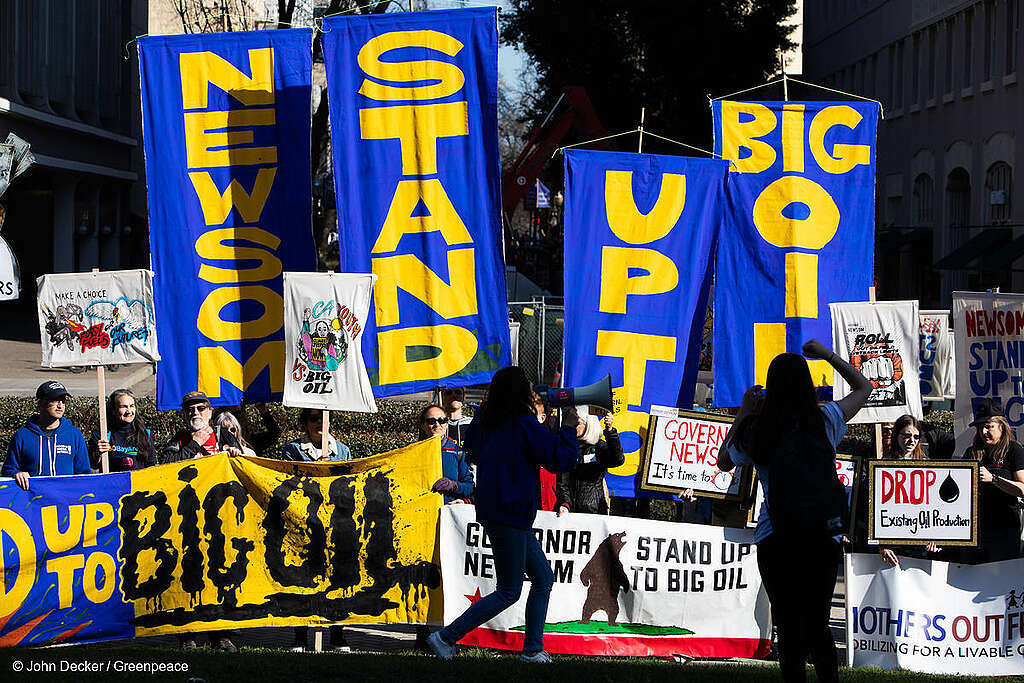
Tell Governor Newsom: Phase out fossil fuels in California.
Report introduction
In January 2019, California’s Governor Gavin Newsom was inaugurated as the leader of the world’s fifth largest economy at a time of great peril and opportunity for our climate. In the next decade, we must cut emissions in half to be on track to limit warming to 1.5°C and avoid the most disastrous consequences of climate change.[1] In recent years, California has taken the lead in the U.S. at enacting strong policies to reduce demand for fossil fuels and holding the line against President Trump’s rollback of federal environmental protections.
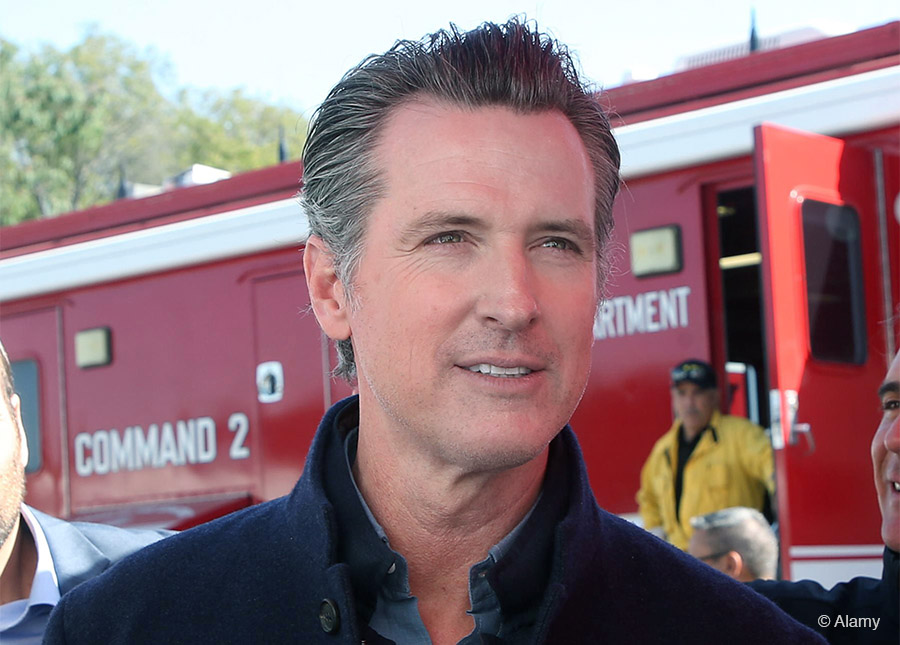
However, the latest science — and a groundswell of grassroots activism — show that Governor Newsom must do more to phase out fossil fuel production in California and ensure a managed decline of oil and gas production in the state, while at the same time, protecting public health and building a just and equitable transition for California’s workers and communities.
This report sets out the rubric by which Governor Newsom will be graded on a Climate Report Card to track his progress towards these critical climate goals.
Despite its track record of strong climate policies to reduce demand for fossil fuels, California remains a major oil and gas producer. The state has remained a top oil and gas producer for decades, although production has been in slow decline. Crude oil production in California peaked in 1985 at 394 million barrels, declining to 169 million barrels in 2018.[2] As recently as 2016, California was the #3 state for oil production (behind Texas and North Dakota); it is now #6, partly due to surging shale production in places like New Mexico and Colorado.[3] Similarly, California’s gas production has also broadly declined since 1985, and the state is currently ranked #15 in production.[4] California crude is among the dirtiest in the world, rivaling Canada’s tar sands in full lifecycle carbon emissions.[5]
Recent studies have highlighted the risk that continued fossil fuel production will undermine strong climate policies and “lock in” unsafe levels of warming.[6],[7] These studies highlight that fossil fuel producing regions, such as California, can and must take steps to phase out fossil fuel production in tandem with strong policies to cut emissions. Two recent analyses of California oil and gas found that a moratorium on new oil and gas permitting would accelerate the production decline — but issuing new drilling permits could maintain production at levels inconsistent with a safe climate.[8],[9] What’s more, those living closest to oil and gas extraction — and who bear the largest health risks from continued drilling — are more likely to be low-income and communities of color.[10]
The Last Chance Alliance — a coalition of more than 750 environmental, health, justice, faith, labor, community, parent, and consumer organizations — has three demands of Gov. Newsom:[11]
- STOP new fossil fuel projects: Lead by issuing no new permits for oil and gas extraction, fossil fuel infrastructure, or petrochemical projects in California.
- DROP existing production: Set a national and global precedent by becoming the first oil- producing state to announce a phase-out of existing production in line with the Paris climate goals, with a just and equitable transition that protects workers, communities, and economies.
- ROLL out setback limits: Begin by first phasing out oil production in places that are suffering most from the impacts of fossil fuel extraction—by creating a 2500-foot health and safety buffer zone between fossil-fuel infrastructure and homes, schools, and other sensitive sites.
Although Newsom started off his term with some missteps, he has recently taken several encouraging actions. Following reports of a surge in oil and gas permitting on his watch and significant conflicts of interest among regulators, Newsom fired the state’s top oil regulator.[12] He signed the 2019 budget appropriations bill which includes funding for two studies into “strategies for managing the decline in the demand and supply for fossil fuels” and “ways to significantly reduce emissions from vehicles.”[13] In October 2019, Newsom signed a bill to limit oil and gas development on state lands[14] — a move that could potentially stymie President Trump’s plan to increase drilling on federal lands.
On November 19, 2019, Newsom’s administration announced three actions “to safeguard public health and the environment, advance California’s goal to become carbon-neutral by 2045 and manage the decline of oil production and consumption in the state.”[15] This move marks California as the first major fossil fuel producing region in the United States to seriously begin a process to manage the decline of fossil fuel production[16] — although it remains to be seen how far these reforms will go in reducing oil and gas production.
The ultimate impact of these proposed reforms is unknown, and on their own, they do not meet the level of ambition necessary to match the scale of the climate and public health crisis. We therefore propose a “scoring rubric” to set criteria to assess how well Newsom and his administration manage the decline of oil and gas production.
As climate disasters and planned blackouts roil the state, the need for urgent climate action could not be clearer.
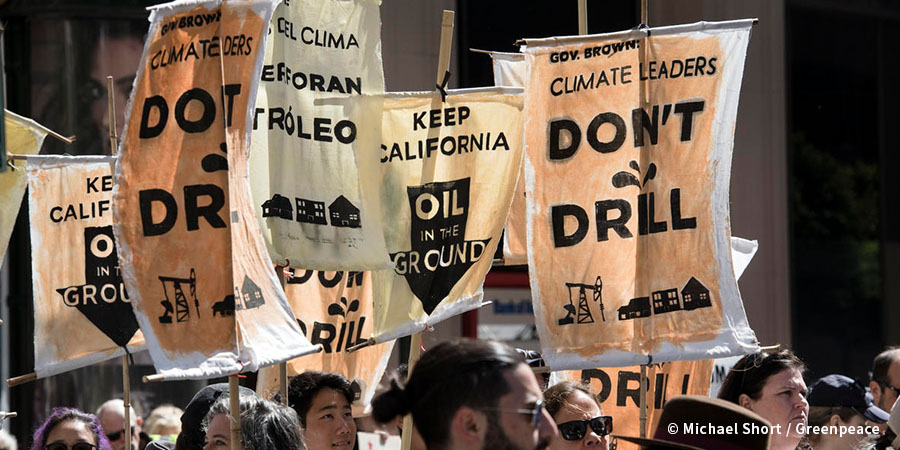
No new permits and a managed decline for oil and gas
Recent studies have shown that plans to expand fossil fuel extraction threaten to undermine the goals articulated in the Paris Climate Agreement.[17] Oil-producing regions such as California must enact policies that target a decline in production alongside policies that reduce demand for fossil fuels.
Governor Newsom must put an end to new permits for oil and gas production and enact a phase-out of existing production in line with the Paris goals.
Research by FracTracker[18] and Consumer Watchdog[19] found that, over the first half of 2019, Governor Newsom’s administration approved 35% more drilling permits, 28% more total permits, and 103% more well-stimulation permits compared with a similar period in 2018, the final year of Gov. Brown’s administration. Those reports also uncovered evidence that numerous staffers at the Division of Oil, Gas, and Geothermal Resources (DOGGR) had significant financial conflicts with the industry they were charged with regulating. Following a July staff shake-up, no new permits for fracking or acidizing have been approved in the state.[20] Other oil and gas permits have moved forward, but at a slower pace.[21]
Governor Newsom’s November 2019 announcement did not end all new oil and gas permits in the state, but it did signal future changes for two types of permits.
First, the Department of Conservation (DOC) ordered the “halt of approvals of new oil extraction wells that use high-pressure steam to break oil formations below the ground.” It is unclear whether the moratorium on these permits will be permanent, as regulators “could require certain safety practices, update regulations to impose new rules, or prohibit the practice altogether.” New regulations enacted earlier in 2019 prohibit “surface expressions,”[22] which are leaks to the surface of oil and water, often associated with high-pressure cyclic steaming, including at the Cymric field in Kern County. A potential ban on high-pressure cyclic steaming would not necessarily halt production from all such wells, as enhanced oil recovery could continue at lower pressures.
Second, DOC ordered that “pending applications to conduct hydraulic fracturing and other well stimulation practices will be independently reviewed.” This policy encompasses an “independent audit of its permitting processes for well stimulation and underground injection control,” as well as a “third-party scientific review of pending well stimulation permit applications” while the audit is being completed. Again, it is unclear what will eventually come from these two new processes, whether they will lead to a full moratorium, a decline in fracking permit approvals, or merely another review process on the way to routine approvals.
The November 2019 announcement did not encompass all oil and gas permitting, nor did it explicitly target a production phase out consistent with the Paris goals. However, the announcement did refer to the goal of managing “the decline of oil production and consumption in the state” — an encouraging frame of reference that suggests the Governor does not see a long-term role for oil production in California.
As California’s oil production is already in decline, the key task will be to adopt policies that set an ambitious pace consistent with limiting warming to 1.5°C, while taking into account equity and public health issues for California’s workers and communities. The recent Production Gap report showed that global oil production must decline by at least 30% from 2020 to 2030 to put us on a pathway consistent with 1.5°C.[23] (Other studies indicate that faster declines in oil use will be necessary.)[24] California has a robust and diversified economy with adequate resources to successfully manage the economic dislocations of a production phase out. For reasons of global equity, California should pursue an even faster phase out of existing production than the global average.[25]
Studies by Stockholm Environment Institute (SEI) and Oil Change International (OCI) both indicate that a policy of no permits for new wells would achieve this faster phase out. Both studies estimate that production from existing wells will decline by about 10% annually, which would cause California’s oil production to fall roughly 75% from current levels (169 MMbbl in 2018) to around 40-50 MMbbl in 2030.[26] The OCI report also models a phase out of existing production within a 2500 foot public health buffer. Figure 1 compares these ‘Paris compliant’ production scenarios with the EIA forecast from the 2019 Annual Energy Outlook.[27]
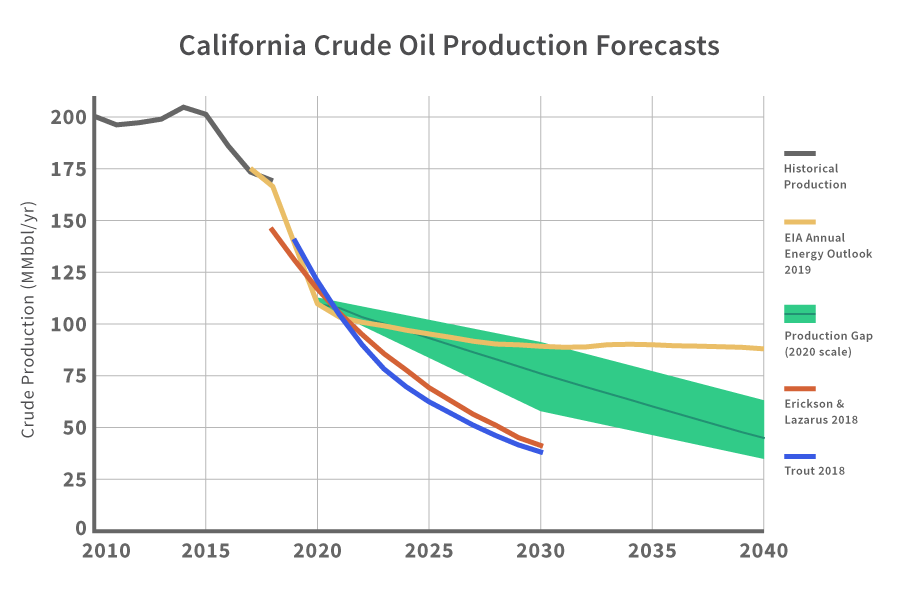
This indicates that if Governor Newsom is able to successfully end all new oil and gas permitting, he would also achieve the goal of putting California on a ‘Paris-compliant’ pathway. Such an ambitious phase out would cement California’s position as a global leader on climate policy. However, less ambitious reforms of oil and gas permitting would risk allowing oil production to continue at elevated levels for years to come. Any such ‘supply-side’ phase out should be paired with aggressive policies to reduce demand for fossil fuels (many of which California has already proposed) in order to minimize carbon leakage.
Rubric:
- A: No new permits for oil and gas extraction, fossil fuel infrastructure, or petrochemical projects in California, and a public commitment to manage the decline of California’s oil production at a pace consistent with the Paris Climate goals and global equity.
- B: No new permits for a significant portion of oil and gas extraction, fossil fuel infrastructure, or petrochemical projects in California
- C: New rules or regulations that slow the pace or eliminate permits for some oil and gas extraction, fossil fuel infrastructure, or petrochemical projects in California
- D: Public statements in support of reforming oil and gas permitting, but no policy change
- F: Status quo
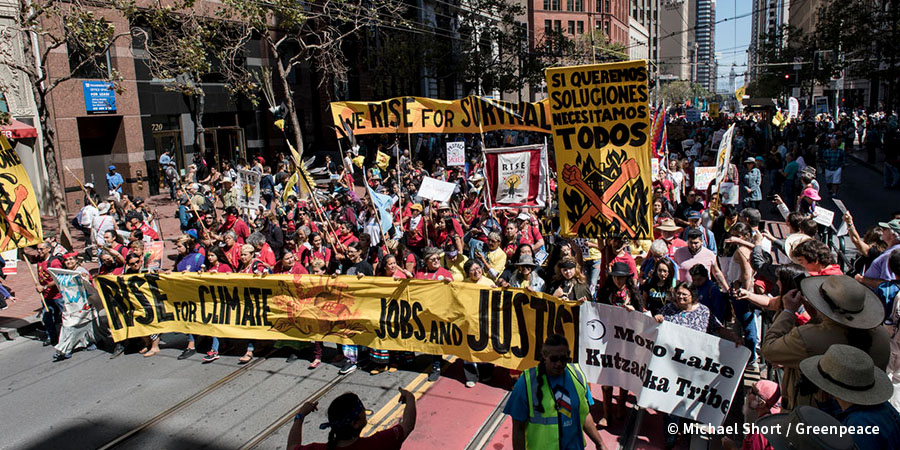
A just and equitable transition
Crucial to the success of any supply-side climate policies in California will be policies to ensure that oil industry workers and extraction-dependent communities, such as Kern County, are left better off after the transition, and are not abandoned.
The November 2019 announcement refers to “the state’s first major workforce investment of $165 million over five years to help enable economic transition away from dependence on fossil fuels.” This is likely a reference to Apprenticeships for a Green Economy, a program which uses revenues from California’s cap-and-trade program to fund job training and apprenticeship programs targeted at “disadvantaged” and “displaced workers resulting from climate policies or automation.”[28]
The state has already completed a series of community workshops exploring questions around the decline of the oil industry, in connection with the budget request to study a managed decline of oil and gas.[29] However, the Newsom Administration does not need to wait for this study to wrap up in order to begin implementing a comprehensive suite of just transition programs to ensure wage replacement, benefits, and retirement support for existing workers, as well as job retraining and relocation support for those who want it.[30] Workforce and community development strategies for rural oil-producing communities will also be crucial, as will policies to ensure transportation access for rural communities during the transition. Sufficient levels of funding and robust participation from all affected stakeholders will be key elements of any successful plan.
Rubric:
- A: Enact policies that ensure that California’s workers and communities are left better off than before the transition. Such programs should include dedicated and sufficient funding for wage replacement, healthcare and other benefits, and retirement support programs, job training and relocation programs, geographically targeted workforce development, and tax base replacement.
- B: Strong just transition policies that fall short in some way or leave some workers and/or communities behind
- C: Weak just transition policies that leave significant portions of worker and community needs uncertain
- D: Public statements in support of a just transition, but no policy change
- F: Status quo
Public health safety buffer
Finally, in the Newsom Administration’s November 2019 announcement, DOC ordered that “rules for public health and safety protections near oil and gas extraction facilities” be updated and strengthened in order to “to protect residents and communities” near those facilities. This reform envisions “a series of pre-rulemaking workshops” and will consider “a range of protective measures, including prohibiting oil and gas activities within close proximity of homes, schools, hospitals, and parks.”
In 2015, the California Council on Science and Technology (CCST) published a state mandated study on the direct and indirect impacts of well stimulation techniques, and oil and gas production generally. The study concluded that “emissions concentrated near all oil and gas production could present health hazards to nearby communities in California.” The report summarized public health research showing that “the most significant exposures to toxic air contaminants such as benzene, aliphatic hydrocarbons and hydrogen sulfide occur within 800 m (one-half mile) from active oil and gas development” and concluded that health impacts on California communities should be studied and recommended that policymakers “develop policies such as science-based surface setbacks, to limit exposures.”[31]
Many of California’s oil and gas wells are located in populated regions of the state. In particular, the Los Angeles basin oil fields are located in the middle of the state’s largest metropolitan area. However, even in less densely populated regions, humans live, work, and play in close proximity to oil and gas production, with potential negative health consequences. Many of these impacted areas are low-income or communities of color.[32] Analysis from FracTracker has shown that, statewide, roughly 12% of active and newly permitted oil wells are within 2500 feet of a residence, school or hospital, and that roughly 850,000 residents live within that zone.[33]
Environmental justice advocates and community members have called for setbacks as an initial step to protect vulnerable communities living near oil and gas sites. In August 2018, the city of Arvin, in the heart of the Central Valley oil fields, became the first town to enact setbacks of 300 feet for new development and 600 feet for new operations near sensitive sites.[34],[35] Advocates in Los Angeles are also pushing a setback ordinance.[36]
Rubric:
- A: Enact a science-based public health buffer (or setback) prohibiting oil and gas activity within a minimum of 2500 feet of residences, schools, parks, hospitals, or other sensitive locations
- B: Enact a public health buffer that is smaller than 2500 feet but prohibiting oil and gas activity within a minimum of 2,000 feet of residences, schools, parks, hospitals, or other sensitive locations.[42]
- C: Enact other regulations that aim to protect public health from the impacts of oil and gas activity
- D: Public statements in support of public health regulations, but no policy change
- F: Status quo
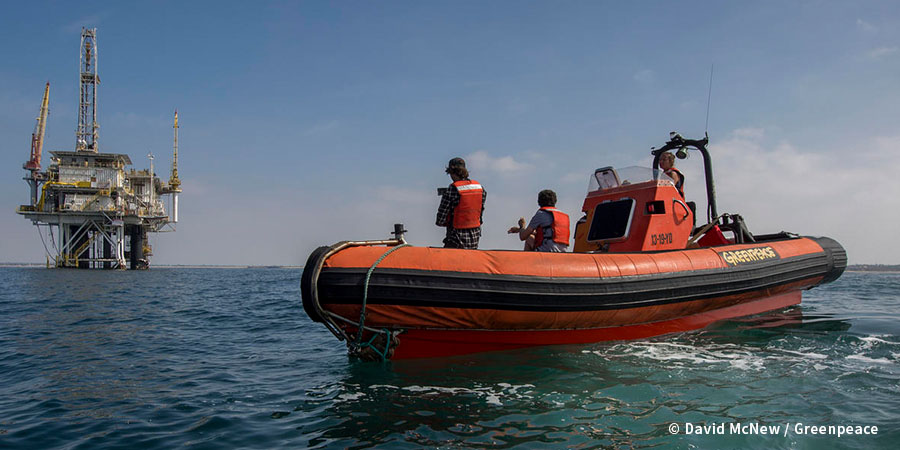
Conclusions
Governor Newsom has taken some encouraging policy steps and has signaled that the oil and gas industry will play a declining role in California’s economy. If Governor Newsom can follow up these moves with an ambitious and visionary plan to phase out oil and gas production in the state, he would affirm California’s status as climate policy leaders, setting the pace for the U.S. and the world. What’s clear is that Californians from frontline communities and around the state will be watching his next moves with interest, and demanding solutions that leave no one behind.
Glossary
Glossary
Well Stimulation – Techniques that “enhance oil and gas production by making the reservoir rocks more permeable, thus allowing more oil or gas to flow to the well.” These techniques include hydraulic fracturing (which aims to “create sufficient pressure in the well to induce fractures in the reservoir”) and acidizing stimulation (which use “acid to dissolve materials impeding flow”).[37]
Hydraulic Fracturing – Techniques that create fractures in an oil reservoir by increasing the pressure of an injected fluid until the rock breaks. The fractures are then kept open by introducing a proppant (such as sand) or through acid etching, and which then allow more oil to flow.[38]
Enhanced Oil Recovery – Any technique for increasing oil production that involves the “injection of fluids underground to increase the flow of oil and gas to the surface.” Injected fluids can be water, carbon dioxide, steam or chemicals, and are often introduced via a separate injection well.[39]
Cyclic steaming – A technique that involves “periodic injection of steam followed by a well shut-in period to allow the heat to reduce the oil viscosity, followed by a period of production, after which the cycle repeats.”[40]
Surface Expression – A surface expression “can occur when steam injected under pressure to produce oil breaks through natural geologic barriers and comes to the surface.”[41]
Jan 2021 update endnotes
1. Burke, M. & Heft-Neal, S. 2020. Indirect mortality from recent wildfires in CA. September 11. http://www.g-feed.com/2020/09/indirect-mortality-from-recent.html
2. Governor Gavin Newsom. 2020. Executive Order N-79-20. https://www.gov.ca.gov/wp-content/uploads/2020/09/9.23.20-EO-N-79-20-Climate.pdf
3. https://newsomwellwatch.com/
4. Tucker, L. 2021. Newsom Administration Doubles New Oil And Gas Production Well Permits, Misses Deadline for Drilling Setback Rule. Consumer Watchdog & FracTracker Alliance, January 19. https://www.consumerwatchdog.org/energy/newsom-administration-doubles-new-oil-and-gas-production-well-permits-misses-deadline
5. Newsom, G. 2017. A sustainable world can start in California. Medium, December 5. https://medium.com/@GavinNewsom/a-sustainable-world-can-start-in-california-df8c0d1332d4
6. California Department of Conservation. Well Stimulation National Laboratory Scientific Review. https://www.conservation.ca.gov/calgem/Pages/Well-Stim-National-Lab-Scientific-Review.aspx
7. https://cleanpowerexchange.org/school-kids-to-breathe-easier-governor-newsom-signs-ab-841/
8. California Department of Conservation. Public Health Rulemaking. https://www.conservation.ca.gov/calgem/Pages/Public-Health.aspx
9. Ferrar, K. 2020. Documenting emissions from new oil and gas wells in California. FracTracker, November 18. https://www.fractracker.org/2020/11/documenting-emissions-from-new-oil-and-gas-wells-in-california/
10. Ferrar, K. 2020. People and Production: Reducing Risk in California Extraction. FracTracker, December 17. https://www.fractracker.org/2020/12/people-and-production/
Report endnotes
1. The Intergovernmental Panel on Climate Change (IPCC). 2018. Global Warming of 1.5°C. https://www.ipcc.ch/sr15/
2. U.S. EIA. California Field Production of Crude Oil. https://www.eia.gov/dnav/pet/hist/LeafHandler.ashx?n=PET&s=MCRFPCA1&f=A
3. U.S. EIA. Crude Oil Production. https://www.eia.gov/dnav/pet/pet_crd_crpdn_adc_mbbl_a.htm; U.S. EIA. Rankings: Crude Oil Production, August 2019. https://www.eia.gov/state/rankings/?sid=CA#series/46
4. U.S. EIA. Natural Gas Gross Withdrawals and Production. https://www.eia.gov/dnav/ng/ng_prod_sum_a_EPG0_VGM_mmcf_a.htm
5. Wolf, S. & K. Siegel. 2017. Oil Stain: How Dirty Crude Undercuts California’s Climate Progress. Center for Biological Diversity, November. https://www.biologicaldiversity.org/programs/climate_law_institute/energy_and_global_warming/pdfs/Oil_Stain.pdf
6. Muttitt, G. 2016. The Sky’s Limit: Why The Paris Climate Goals Require a Managed Decline of Fossil Fuel Production. Oil Change International. September. http://priceofoil.org/content/uploads/2016/09/OCI_the_skys_limit_2016_FINAL_2.pdf
7. SEI, IISD, ODI, Climate Analytics, CICERO, and UNEP. (2019). The Production Gap: The discrepancy between countries’ planned fossil fuel production and global production levels consistent with limiting warming to 1.5°C or 2°C. http://productiongap.org/
8. Erickson, P. & M. Lazarus. 2018. How limiting oil production could help California meet its climate goals. Stockholm Environment Institute. https://www.sei.org/wp-content/uploads/2018/03/sei-2018-db-california-oil2.pdf
9. Trout, K. 2018. The Sky’s Limit California: Why the Paris Climate Goals Demand That California Lead in a Managed Decline of Oil Extraction. Oil Change International, May. http://priceofoil.org/content/uploads/2018/05/Skys_Limit_California_Oil_Production_R2.pdf
10. Srebotnjak, T. 2014. Drilling in California:: Who’s at risk? Natural Resources Defence Council, October. https://www.nrdc.org/sites/default/files/california-fracking-risks-report.pdf
11. Last Chance Alliance. https://lastchancealliance.org/; see also California Oil & Gas Policy Brief. June 2019. Our Last Chance: Phasing Out Fossil Fuels. https://lastchancealliance.org/wp-content/uploads/2019/07/California-Oil-and-Gas-Policy-Brief-Last-Chance-Alliance.pdf
12. CBS SF. 2019. Newsom: Soaring Number Of Fracking Permits Led To State Top Oil Regulator’s Firing. July 12. https://sanfrancisco.cbslocal.com/2019/07/12/newsom-soaring-number-of-fracking-permits-led-to-state-top-oil-regulators-firing/
13. California Assembly Bill No. 74. Budget Act of 2019. https://leginfo.legislature.ca.gov/faces/billTextClient.xhtml?bill_id=201920200AB74
14. Associated Press. 2019. Gov. Gavin Newsom signs bill limiting oil and gas development. October 12. https://www.latimes.com/california/story/2019-10-12/gov-gavin-newsom-signs-bill-limiting-oil-and-gas-development
15. California Department of Conservation. 2019. California Announces New Oil and Gas Initiatives. November 19. https://www.conservation.ca.gov/index/Pages/News/California-Establishes-Moratorium-on-High-Pressure-Extraction.aspx
16. Last Chance Alliance. 2019. California Sets Global Precedent by Becoming First Major Oil Producer Starting Process to Phase-Out Oil Supply. November 19. https://lastchancealliance.org/california-sets-global-precedent-by-becoming-first-major-oil-producer-starting-process-to-phase-out-oil-supply/
17. SEI et al. 2019
18. Ferrar, K. 2019. Permitting New Oil and Gas Wells Under the Newsom Administration. FracTracker Alliance, July 11. https://www.fractracker.org/2019/07/permitting-more-oil-gas-newsom/
19. Scow, A. 2019. Watchdogs Call For Resignations & Permit Freeze As California Oil Regulators Approve Surge In Well Permits While Personally Invested In Oil Companies. Consumer Watchdog, July 11. https://www.consumerwatchdog.org/energy/watchdogs-call-resignations-permit-freeze-california-oil-regulators-approve-surge-well
20. Wilson, J. 2019. California has gone months with no new fracking permits. But dozens of illegal oil spills are flowing. Palm Springs Desert Sun, September 13. https://www.desertsun.com/story/news/environment/2019/09/13/california-no-new-fracking-permits-doggr-crowfoot-oil-gas-spills/2301694001/; Cox, J. 2019. Newsom administration quietly stalls fracking permits. Bakersfield.com, September 16. https://www.bakersfield.com/news/newsom-administration-quietly-stalls-fracking-permits/article_25b4ca7c-d64f-11e9-a117-37f8459db19a.html
21. Tucker, L. 2019. Newsom Freezes New Fracking Permits In California & Slows Rate of Oil Well Approvals Since Summer; 2019 State Oil Well Permits Still Outpace 2018. Consumer Watchdog, November 18. https://www.consumerwatchdog.org/energy/newsom-freezes-new-fracking-permits-california-slows-rate-oil-well-approvals-summer-2019; see also http://www.newsomwellwatch.com/.
22. California Department of Conservation. Oil Field Surface Expressions. https://www.conservation.ca.gov/calgem/Pages/Chevron-Cymric-oil-spill.aspx
23. SEI et al. 2019. Note the trends shown in Figure 1 are global oil production levels consistent with 1.5°C (second panel of Figure ES.2, p. 4) scaled down to match the EIA forecast for California’s production in 2020.
24. For example see the studies shown in Figure 1 from Donaghy, T. 2019. Real Climate Leadership: Why The Next President Must Prioritize A Fossil Fuel Phase Out. Greenpeace USA, June. https://prod.greenpeaceusa.info/usa/reports/fossil-fuel-phaseout/
25. Koski, J., S. Kartha & P. Erickson. 2019. Principles for aligning U.S. fossil fuel extraction with climate limits. Stockholm Environment Institute, February. https://www.sei.org/wp-content/uploads/2019/02/principles-for-aligning-fossil-fuel-extraction-w-climate-limits.pdf
26. Erickson et al. 2018, Figure 3; Trout 2018, Figure 10.
27. U.S. EIA. 2019. Annual Energy Outlook 2019 (AEO19). Table: Lower 48 Crude Oil Production and Wellhead Prices by Supply Region. https://www.eia.gov/outlooks/aeo/data/browser/#/?id=71-AEO2019&cases=ref2019&sourcekey=0; The California crude production forecast shown in this figure is the sum of the “Lower 48 Onshore: West Coast” and “Lower 48 Offshore: Pacific: State” time series. Note that EIA has revised its West Coast and Pacific crude production forecasts downward in the past few years. The 2017 AEO forecast that production would reach 200 MMb/d in 2020.
28. California 2019-2020 State Budget. Enacted Budget Summary Information: Environmental Protection. http://www.ebudget.ca.gov/2019-20/pdf/BudgetSummary/EnvironmentalProtection.pdf
29. Cox, J. 2019. Workshop looks at ways of managing the decline of California’s oil industry. Bakersfield.com, November 13. https://www.bakersfield.com/news/workshop-looks-at-ways-of-managing-the-decline-of-california/article_c9330db4-067c-11ea-811e-0f411c49be05.html
30. For one example of a comprehensive state-level just transition plan see Pollin et al. 2019. A Green Growth Program for Colorado. Political Economy Research Institute, April 14. https://www.peri.umass.edu/publication/item/1168-a-green-growth-program-for-colorado
31. Long et al. 2015. An Independent Scientific Assessment of Well Stimulation in California. Volume II: Potential Environmental Impacts of Hydraulic Fracturing and Acid Stimulations. California Council on Science and Technology (CCST) & Lawrence Berkeley National Laboratory, July. https://ccst.us/wp-content/uploads/160708-sb4-vol-II-7.pdf
32. Srebotnjak 2014
33. Trout 2018, pp. 22-23, Appendix II; see also Ferrar, K. 2019. Impact of a 2,500′ Oil and Gas Well Setback in California. FracTracker Alliance, July 2. https://www.fractracker.org/2019/07/impact-of-a-2500-oil-and-gas-well-setback-in-california/
34. Ferrar, K. 2018. Arvin, CA Setback Ordinance Passes Unanimously! FracTracker Alliance, August 15. https://www.fractracker.org/2018/08/arvin-ca-setback-ordinance-passes/
35. Thompson, G. 2019. Meet the Millennial Mayor Who Took On Big Oil—and Won. The Nation, July 12. https://www.thenation.com/article/arvin-california-oil-drilling-resistance/
36. City New Service. 2019. Residents Say They Will Demand Greater Restrictions on Oil, Gas Drilling. October 15. https://www.nbclosangeles.com/news/local/Residents-Say-They-Will-Demand-Greater-Restrictions-on-Oil-Gas-Drilling-563131961.html
37. CCST 2015, Table 1.1-1
38. CCST 2015, Table 1.1-1
39. Clean Water Action. Enhanced Oil Recovery: A Threat to Drinking Water. https://www.cleanwateraction.org/sites/default/files/docs/publications/EOR%20Risk%20and%20Oversight%20Factsheet_0.pdf
40. CCST 2015, p. 58-59
41. California Department of Conservation. Oil Field Surface Expressions. https://www.conservation.ca.gov/calgem/Pages/Chevron-Cymric-oil-spill.aspx
42. Rubric updated on 01/05/2021 for clarity.

